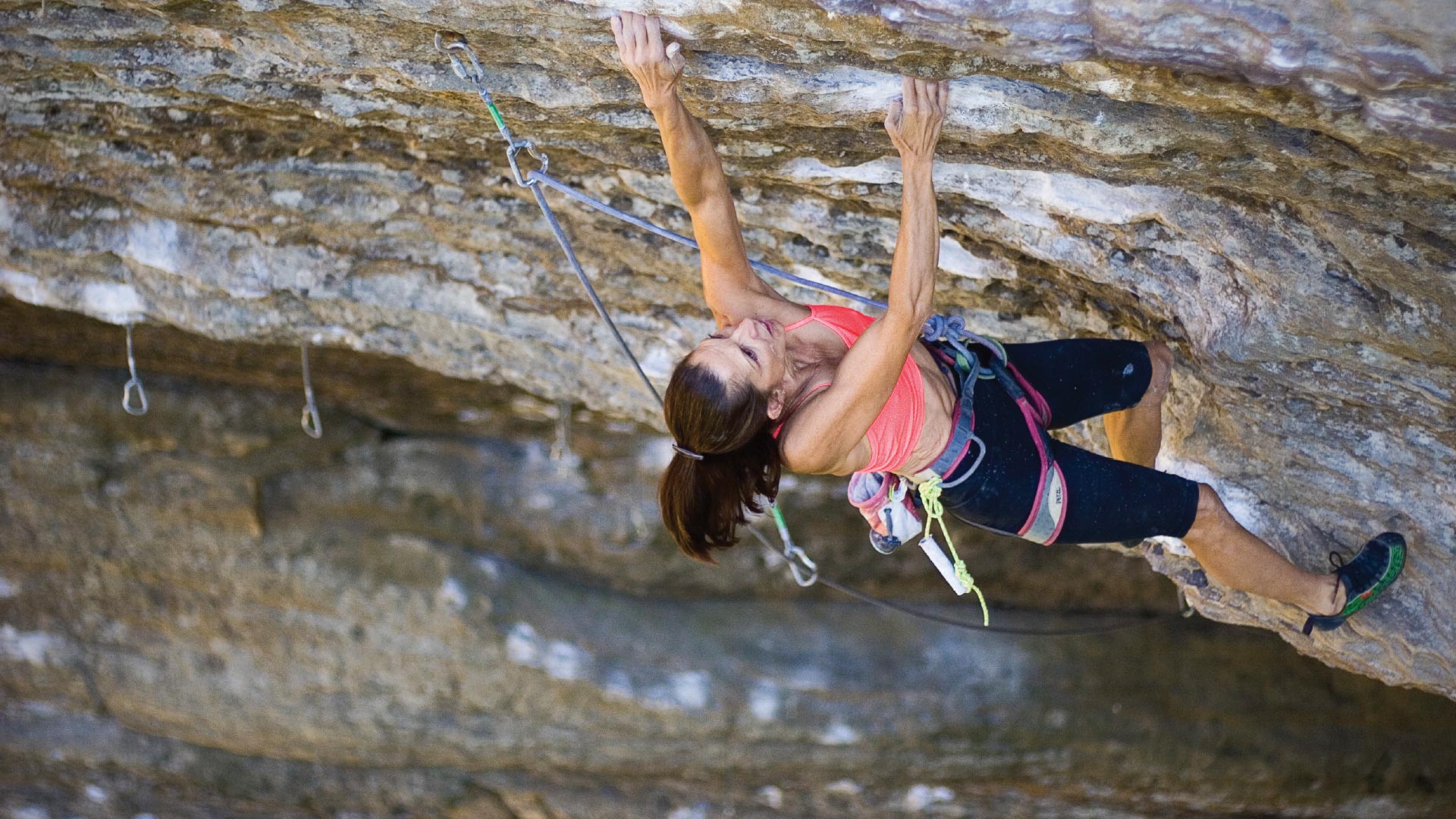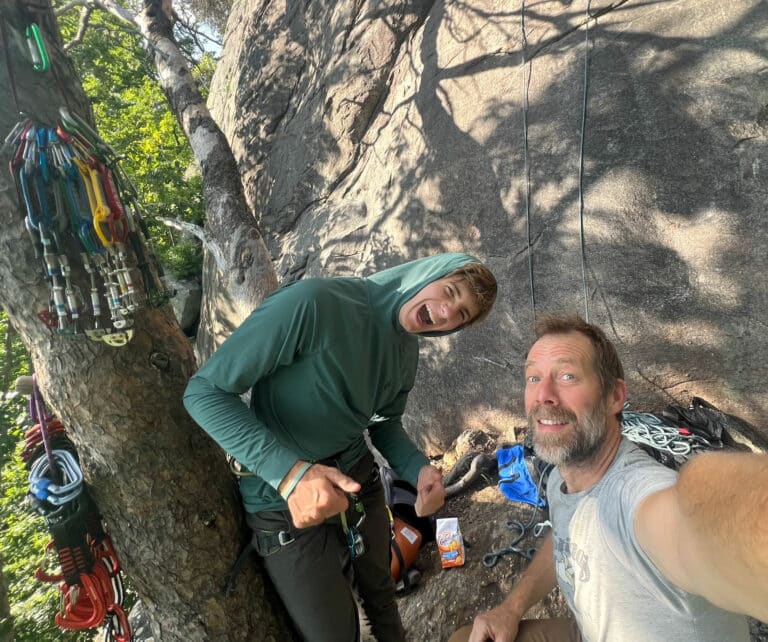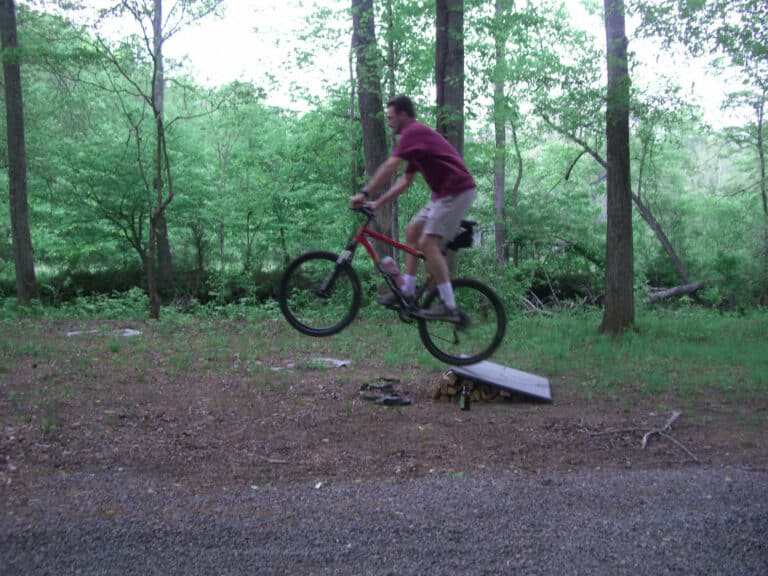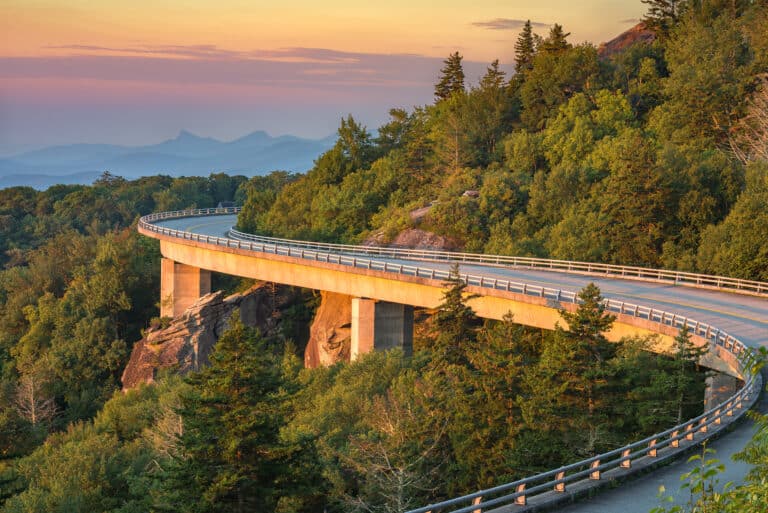Getting into an adventure sport can be intimidating, especially as an adult, but these four later-in-lifers didn’t let that stop them from pursuing new horizons.
It’s the final weekend of the 11th annual Michaux Mountain Bike School in south-central Pennsylvania. The parking lot at Camp Thompson is packed with trucks and vans and small RVs, racked up, stickered up, beat up. The hum of a coasting freehub weaves through the cars past a grid of one-room cabins.
I unload my bike and follow the sound to a modest dining hall where a crowd of cyclists is already gathered. I find Gail Robillard among the brightly kitted posse. She’s straddling a red-orange 2014 Salsa El Mariachi, a look of concentration creasing the brow beneath her white bandana. When I introduce myself, she dramatically kneels over her handlebars.
“I thought someone writing about adventuring later in life would be, you know, a little later in life!” she says. “You’re so young!”
Full disclosure: I’m 27 years old. Gail, on the other hand, is 65. She has a point. I’m probably the least capable person when it comes to writing about the realities of learning an adventure sport later in life. I make some awkward quip about how the young would do well to learn from the wise and she gives me an eye roll before Zach Adams, the school director, launches into his pre-camp spiel.
There are two camps running simultaneously this weekend: a one-day Fundamental Skills Camp and a three-day Advanced Maneuver Camp. Gail and I are signed up for the former. This will be Gail’s second year at Michaux, though she had to leave early last year after crashing and bruising her ribs.
An accounting manager from Wilmington, Delaware, Gail has been a road cyclist for the past 14 years. Two years ago, at the behest of her local cycling club, she tried mountain biking and felt a thrill she hadn’t experienced since she rode horses back in her 20s.
“Life is an adventure, and if I don’t take it, I’m gonna miss it,” she told me over the phone before Michaux. “Being 65 wakes you up to the fact that you don’t have all that much time to continue this adventure. The older I get, the crazier I may get, sure, but if I don’t use it, I’m going to lose it, so I better keep at it.”
Whatever she may think about my age, Gail is in good company here at Michaux. As I look around at the camp attendees, cyclists my age—that is under 30—are in the minority. Most are middle aged or older men ranging the entire gamut of experience from beginner to shredder. Were it not for a 10-year-old boy, I would have been the youngest participant in my breakout group by a decade.
The small turnout of twentysomethings is surprising, but not altogether unexpected. A 2011 study in Transportation Research found that over the past 20 years, nearly all of the cycling industry’s growth in the States has been among men ages 25-64. Mountain biking especially requires an equipment intensive investment up front, one that easily racks up to be a grand or more. Cyclists in their early 20s barely have the money to maintain their bikes, let alone drop a few hundred bucks on a multiday skills clinic.
When it comes to spending power, Gen Xers and early Baby Boomers have the upper hand, yet the outdoor industry continues to exclude these age groups from its marketing. Though an increasing number of brands like Giant and The North Face are launching campaigns to address the gender gap, millennial remains the buzzword. Think about the latest advertisement you’ve seen for an outdoor brand. More likely than not, the featured faces are strong, beautiful, and above all, young.
It’s no wonder, then, that adults, especially newcomers to a sport, feel a little ostracized from the industry. Where is there room for middle-aged beginner kayakers and retiree mountain bikers when our newsfeeds show the young and restless going bigger and being bolder? If you only associate rock climbing with Alex Honnold, the age-old adage, “I’m too old for that,” feels like a fair conclusion.
Should you need confirmation, there is entirely too much research to back up that train of thought. Dozens of studies have proved that things like muscle mass and bone density decrease as you age, recovery time increases, and that learning in general is just “harder” once you’re an adult.
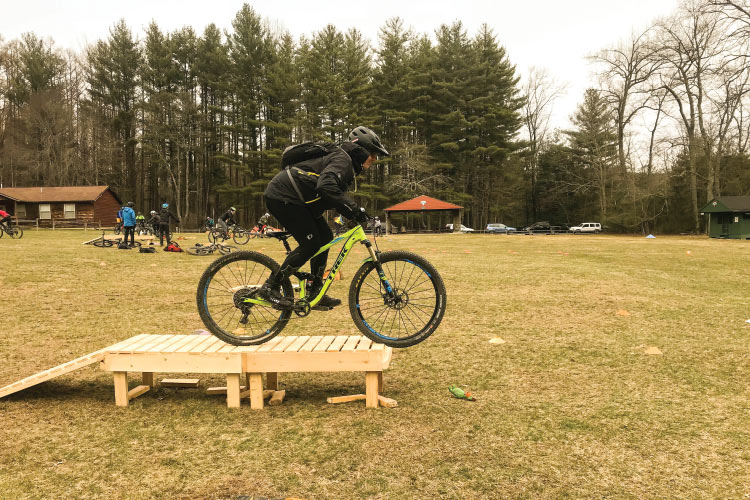
I’m going to eschew any sense of PC here and say, bullshit.
That’s not to say the science isn’t sound, or that adults don’t have more obstacles when it comes to learning an adventure sport. Work, family, illness, tragedy. Life throws unexpected curveballs sometimes, and it can get more complicated the older we get, but that doesn’t mean age is what’s holding us back from learning a new adventure sport.
In fact, recent research shows that older athletes, by necessity, train more efficiently and can outperform their younger counterparts specifically in endurance style sports. A study published in 2014 by PLOS ONE analyzed 1,212 ultrarunners and found that younger athletes had higher injury rates.
The injuries were typically the result of overtraining and inexperience and sometimes led to those athletes giving up running later in life. That might explain why, in a study conducted a year earlier by the Journal of Strength and Conditioning Research, the average age of ultrarunners was 43. Of those 1,345 runners studied, the average age for running an ultra for the first time was 36, with ages 40 and 50+ following close behind.
In the larger world of sports, professional athletes are staying in the game longer, too. Olympic swimmer Dara Torres took home three silver medals at the 2008 Games in Beijing. She was 41 at the time. Olympic cyclist Kristin Armstrong brought home gold at the 2016 Games in Rio on the eve of her 43rd birthday. That same year, ultrarunner Karl Meltzer set the record for the fastest supported attempt of the Appalachian Trail when he was 48 years young.
And, if you need a non-professional for further proof, last year 82-year-old Dale Sanders became the oldest person to hike the entire Appalachian Trail, proving that anyone, regardless of age or experience, can accomplish whatever they put their minds to.
So if we have the role models, the stable bank accounts, the life experience to draw upon in challenging times, shouldn’t it stand to reason that the older we get, the more inclined we are to try new things, take risks, explore, dream, discover? Well, if you’re afraid of falling on your face, maybe not.
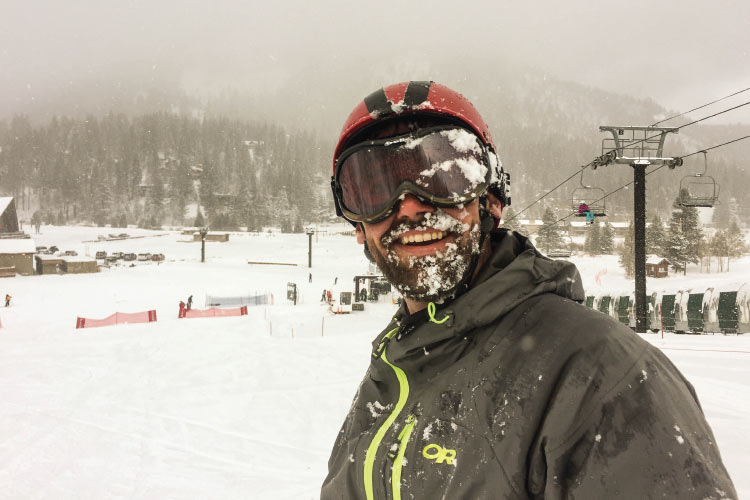
The Beginner’s Mind
Steve Augustine of Bryson City, N.C., had been a whitewater kayaker and instructor for nearly 20 years when he decided to pick up downhill skiing at the age of 35. Most of his kayaking buddies were already skiers, and pretty rippin’ ones at that, but as a native of Florida who then relocated to the Southeast, it was rain, not snow, that Augustine was more accustomed to.
On a trip to Lake Tahoe one Thanksgiving, Augustine decided it was high time he hit the slopes. He spent most of the first day on the bunny runs with his ever-patient girlfriend at the time (and now wife) Laura Farrell, who is one of those multisport shredders.
He took a few falls, mastered the pizza wedge, and at day’s end, he was starting to feel like the green runs were cake. The next time he went out, Augustine went for the blue, only to bail midway down the mountain and posthole his way back to the lodge.
“The time it takes to learn sports like this is intensive,” he says. “You’re going to fail 15 more times before you get to that success. It’s tough to not just be really good at something when you are already good at one thing. As we get older, we get set in our ways and we forget the student mind, the beginner mind. It’s harder and harder to step outside of the comfort zone because you’ve done such a good job cultivating it. You have to trust the process and embrace the ebb and flow of learning.”
To be clear, Steve’s story does not end with him sending double black diamonds, walking away with a World Cup title, and becoming skiing’s most celebrated underdog of all time (though if this is what you want, buddy, then DO IT TO IT). His story doesn’t end, period, because next winter, he’ll be right back out on the slopes, gaper gap and all, continuing to improve with every face-plant and clean run alike.
His commitment to “the beginner’s mind” is the key ingredient to learning a sport later in life. There will undoubtedly be frustrating moments, and in those dark and dreary depths of newb despair, it’s easy to write off the necessity of continued effort when your friends look so casual carving lines or clearing gaps. But natural talent alone never got anyone anywhere without being in lockstep with ol’ fashioned hard work.
Fox Mountain Guides co-owner Cristin Knowlton will be the first to tell you that in the way of natural climbing talent, the universe gave her zilch.
“I was not athletic at all,” she says of her former life as a part-time legal consultant living in Florida. “I didn’t run, I didn’t play sports growing up, I have no coordination, I have bad balance, like, everything was working against me. I had no inclination to start climbing.”
When her son expressed an interest in joining a local climbing gym, Knowlton and her husband decided maybe they should give it a go, too. That summer they hired a guide with Fox Mountain Guides (FMG) and once a year for many years, they made the pilgrimage to climb real rock in North Carolina.
That was 10 years ago, when Knowlton was 36. In the past decade, she’s climbed all over the world, from Chamonix to Joshua Tree, both on her own and as a client of FMG. About five years ago she received her single pitch instructor certification and went in with lead FMG guide Karsten Delap to purchase the guiding company that had so drastically changed her life.
She says the fundamental lesson for her was to be okay with taking her climbing one step at a time. Too often her friends and even clients envision the most extreme version of climbing when they’re first starting out, and that can contribute a lot of anxiety and misguided apprehensions about the sport. In reality, any adventure sport can be beginner friendly, whether that’s paddling class I and II whitewater or sticking to the green trails at the bike park. It’s all a matter of challenge by choice.
“There is this perception that [climbing] is some dangerous crazy sport but if I can do it, anyone can do it,” she says. “I never had this ultimate goal where I was like, ‘I want to climb the Matterhorn.’ It just evolved, in a check-the-box kinda way, and then I eventually did climb the Matterhorn. I would have never expected my middle-aged self to be fitter than I was when I was 22.”
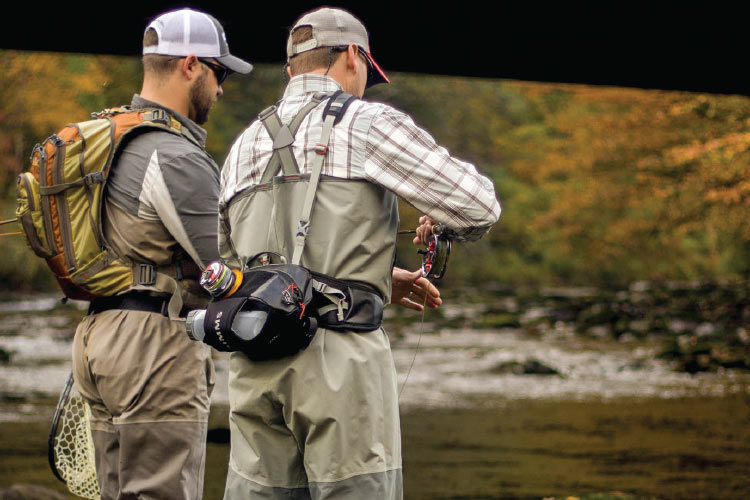
Learning to Fall
Like Knowlton, Margarita Martinez was probably the last person anyone expected (herself included) to become a climber, namely because she had a debilitating fear of heights. Nothing a little friendly peer pressure can’t fix.
At the encouragement of her friends, Martinez, then 34 years old, tried climbing indoors at a gym in Oxford, Ohio. She didn’t get much further than 12 feet off the ground, but as a former dancer, Martinez appreciated the intricacies of balance and concentration that climbing demanded. She was hooked.
She was also extremely humbled, especially after her first outdoor climbing trip six weeks later, when she could only dream of getting as far as 12 feet off the ground. She started going to the gym to focus on strength training and dedicated a lot of her climbing gym time to improving footwork. Still, progress was painfully slow.
“I couldn’t even do a single pull up when I started climbing,” says Martinez. “After three months of trying negatives, I still could not do one. I was in tears. I thought this is just not going to happen. But you just have to tell yourself it will happen. Your body is a machine. It will do whatever it needs to do with the appropriate amount of work. It’s a matter of whether you’re going to put in the work or give up and I wasn’t going to give up.”
Five months after her first time in the climbing gym, Martinez finally got that pull-up. A little over a year after that, she led her first 5.12a. Martinez now lives in the Red River Gorge full-time, and at age 60, she’s showing no signs of slowing down, even with erosive arthritis in both of her hands.
For Martinez, climbing is quite simply fun. She’s not in it to be the best, though much like Cristin Knowlton, she’s intrigued with how far she can take her climbing. This summer, she plans to project a 5.14a in Utah’s Maple Canyon.
More than anything, climbing has provided a playing field for Martinez to conquer her fear of heights head on. She never rushed her progression and listened to her body. For most of that first year of climbing, she thought she would be a top rope climber forever. As backwards as it sounds, it took Martinez learning how to fall to make her want to lead.
“There are a lot more try hard days then send days in climbing, but that limited success is so great because you work so hard. I did not want to die thinking that I was always afraid of heights. I wanted to live, to be able to get through the fear, whether I climbed or not didn’t even matter.”
After eight hours of skills progression and sessioning, the one-day Fundamental Skills Camp at Michaux is coming to a close. Gail is gathered under a pavilion with her breakout group, munching on watermelon in the late afternoon shade.
She tells me she walked some of the trail sections and that dismounting the bike mid-climb still made her uneasy, but all in all, she feels confident that her handling skills are improving.
“I don’t think at this point in time with my mountain biking that I’ve put enough time into it to say this sport is not for me, so I get up, I dust myself off, and I start over again, and that’s okay.”
As I load up my bike, I catch snippets of a conversation between two of the Fundamental Skills riders who are also packing up a few cars down. They’re talking about a local kid in Pennsylvania who sends the pro line on a bike park jump like he was born huckin’ gaps.
“I get so annoyed with these guys who look at him and go, ‘It must be nice to be so naturally talented,’” says the oldest of the two. “I know that that kid has a season pass to the bike park and he’s there every week practicing that line over and over. He’s wrecked on that jump hundreds of times, but they don’t see that.”
Gail is gone by the time I make my way back to the pavilion—it’s a good three-hour drive back to her home in Delaware—but a few days later, I get an email from her: “Sorry I didn’t get a chance to say goodbye. I hope your weekend felt as accomplished as mine did. I will definitely (God willing) go back to Michaux next year. Til then, ride on. Gail.”
OUTDOORS 101
Whether you prefer one-on-one instruction or the support of a group setting, here are 10 of our favorite beginner adventure crash courses for adults!
Cove Creek Canyon Canyoneering
Pura Vida Adventures
pvadventures.com
Course length: 3-5 hours
Location: Cove Creek Canyon, North Carolina
Intro to Outdoor Rock Climbing
Fox Mountain Guides
foxmountainguides.com
Course length: 2 Days
Location: North Carolina
Gym to Crag
Seneca Rocks Climbing School
climbseneca.com
Course length: 2-3 days
Location: Seneca Rocks, West Virginia
Fly Fishing School
Hunter Banks Fly Fishing
hunterbanks.com
Course length: half-day and full-day options
Location: Asheville, North Carolina
Introduction to Whitewater Kayaking
Nantahala Outdoor Center
noc.com
Course length: full-day to five-day options
Location: Bryson City, North Carolina; Atlanta, Georgia
Fundamentals for River Runners
H2O Dreams
h2odreams.com
Course length: 1 day
Location: Saluda, North Carolina
Mountains to Sea: A SUP Adventure for Women
Mind Body Paddle
mindbodypaddle.com
Course length: TBD
Location: Asheville, North Carolina; Charleston, South Carolina
Skill Builder Camp
Michaux MTB School
michauxmtbschool.com
Course length: 3 days
Location: Gardners, Pennsylvania
Fundamental Mountain Bike Skills – Women’s Only
Ninja Mountain Bike Performance
sandiegomountainbikeskills.com
Course length: 1 day
Location: Roanoke, Virginia; Stokesville, Virginia; Raleigh-Durham, North Carolina; Brevard, North Carolina; Chattanooga, Tennessee; Knoxville, Tennessee; Nashville, Tennessee; Atlanta, Georgia
Women’s Backpacking Trip on the Appalachian Trail
Blue Ridge Hiking Company
blueridgehikingco.com
Course length: 3 days
Location: Hot Springs, North Carolina
